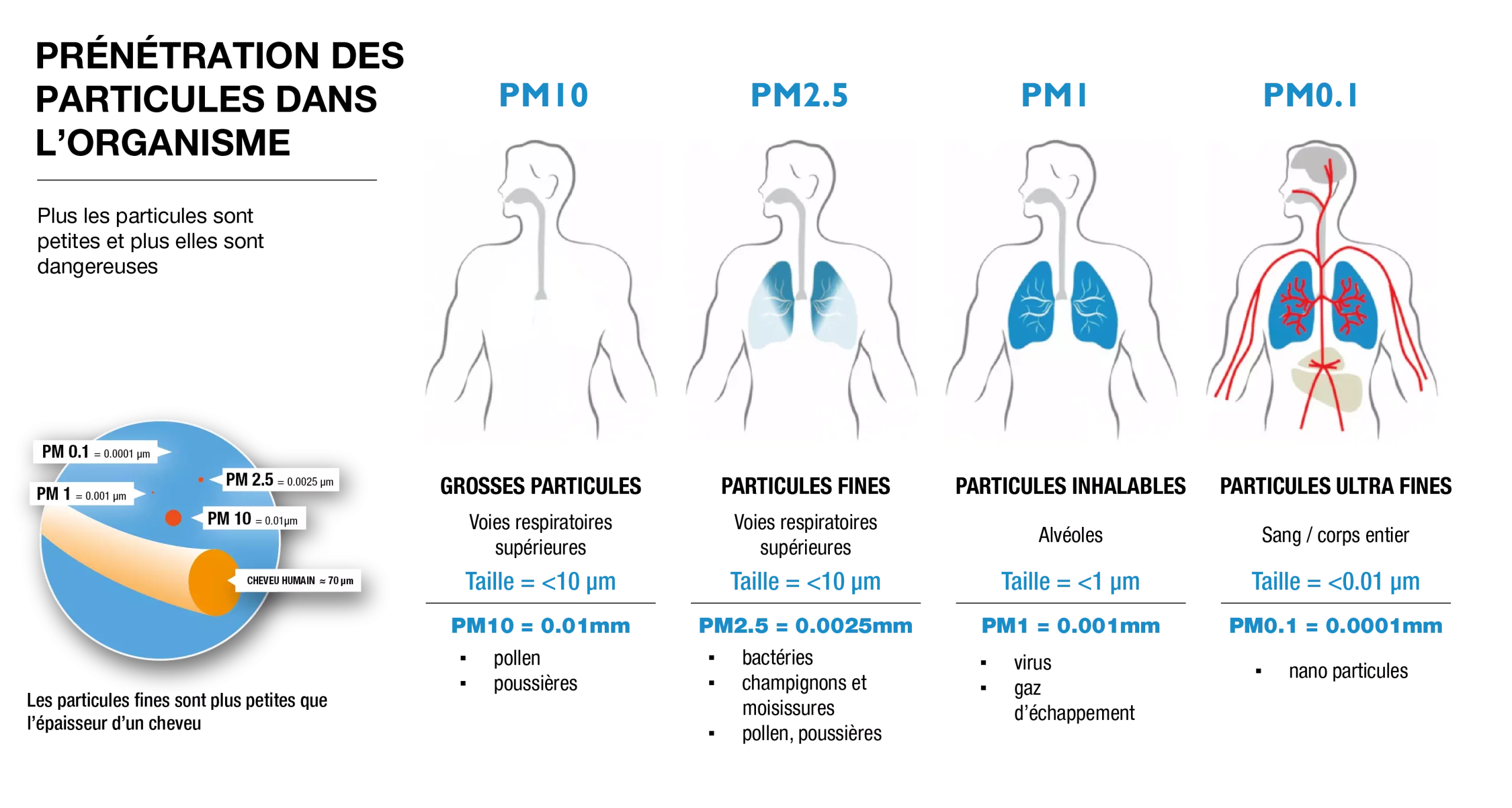
A new enemy in the air: the nanoparticle


The fourth leading cause of mortality in the world, air pollution is becoming a major health issue.
Resulting from air pollutants generated by transportation, industrial activities, the residential sector (heating) as well as agriculture, this type of pollution has a considerable impact on our health.
Very often concentrated in urban areas, but not only, air pollution produces a thick fog, revealing the true density of microparticles present in the environment. This is a cause of cardiovascular diseases, chronic lung diseases, lung cancers, etc. A factor in one death in ten worldwide, air pollution causes many premature deaths, including more than 35,000 deaths in France alone.
Fine particles, with a diameter of less than 10 microns, have the particularity of remaining suspended in the air, and above all have harmful effects on respiratory functions and skin health. Depending on their size, the impact on our health differs. Thus, PM10s (10 microns) tend to affect the cardiovascular system, while PM2.5s (2.5 microns) attack the nervous system. PM2.5s are small enough to seep into the lungs and down to the deepest alveoli, even through paper masks. In terms of skin impacts, particulate air pollution increases the expression of proteins that degrade certain components of the dermis, thus accelerating skin ageing.

Today, only PM10s and PM2.5s are controlled for their negative effects on health. But there are also ultra-fine particles, called nano-particles, the smallest that can be measured and observed today.
These nano particles, or PM0.1s, are smaller than 0,0001 microns, the size of a virus or DNA molecule. Considered even more harmful than the fine particles mentioned above, ultrafine particles penetrate deeper into the body and also cause respiratory and cardiovascular diseases, diabetes, hypertension, as well as impacts on foetal development. The National Agency for Environmental, Food and Occupational Health Safety published a report on the subject in July of this year, sounding the alarm on this subject, since ultra fine particles are thought to be able to reach the bloodstream. As a result, they are thought to be more harmful than PM10s, which are stopped by the respiratory system.
The difficulty with PM0.1s is that they are much smaller, as well as more numerous (80 to 87%), whereas in terms of mass they weigh practically nothing. Therefore, measuring them is a real technical challenge that only a few devices can achieve. Indeed, electric mobility granulometer spectrometer devices are not widespread in France, and thus measurements of these PM0.1s are still uncommon as a consequence.
Today, it is indeed the biggest particles that are measured by the fixed facilities managed by eighteen state-approved associations for air quality monitoring. These facilities measure PM2.5s and especially PM10s, for which France regularly exceeds the regulatory threshold. Concerning PM0.1s, measurements are rare and, in the absence of regulation, these data are only collected as an indication.
Jean-Baptiste Renard, research director at CNRS, considers that the monitoring of these nanoparticles is insufficient. According to him, “their average annual and daily concentrations are too high with reference to guidelines. The new standards set by WHO (5 µg/m3 as an annual average, rather than 10 µg/m3) are far from being reached in urban environments; drastic measures would be necessary to achieve this,” concludes Jean-Baptiste Renard. In France, the upper value is even much higher, at 25 µg/m3 as an annual average. Still according to Jean-Baptiste Renard, “if we lowered that to 5 µg/m3, we would reduce the number of deaths related to air quality by 80%!”.
In the meantime, ultrafine nanoparticle levels remain neglected, despite evidence of their danger. In the transportation sector, for example, new diesel engines indeed no longer emit PM10s and PM2.5s, but they still emit ultrafine nanoparticles, which are therefore not taken into account. Jean-Baptiste Renard states on this subject: “as we do not measure this type of pollution, we say that these vehicles do not pollute. As a result, the population is not adequately protected.” We thus see how relevant it is to decarbonise transportation very quickly!
In a world facing ever more pressing environmental issues, transition
“A stone has no hope of being anything other than
The fourth leading cause of mortality in the world, air